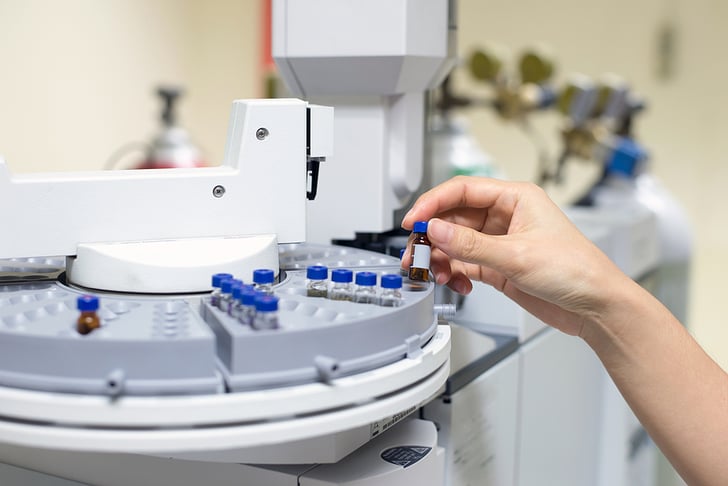Ever wonder if you need to perform quality control (QC) on solvents and solid phase extraction (SPE) consumables? Well, the answer is yes! You want to make sure that your disks and solvents are good to go before running real-life samples and risk losing that sample. Not only that, but QC samples also help to identify any background in your lab's extraction procedures.
Have you ever been in a pickle where you have contamination coming from somewhere and you just can’t seem to pinpoint where?
I know I have…there was a time when I was doing my QC work and found contamination present in all the extractions I performed. I tried a different lot of SPE disks, and the contamination was still present. I then tried doing an extraction without a disk and the contamination was still there. Finally, I took the solvent concentrated down the amount of solvent that I would use during extraction, and lo and behold, the contamination was present. Breaking down the extraction and finding the root source of the contamination was great news because it was a learning process narrowing down where the foreign compounds were originating.
-1.png?width=1253&name=DataImage13%20(1)-1.png)
Now, I just had one thing left to do. I took the same amount of solvent from multiple vendors and lots, concentrated them down to determine if there was a superior brand of solvent. Turns out that some solvent brands have significantly less contamination than others! Now that I was convinced that I needed to switch my solvent vendor I made sure to completely remove the old solvent brand from the lab and clean all extraction equipment with the new uncontaminated brand of solvents. Once that was done, I ran a blank sample through the entire extraction procedure, using the new brand of solvent. The contamination was no longer there, so I was confident that I had solved the problem and was okay with moving onto running some real samples again. Everything turned out okay in the end, but that was quite a project and headache to deal with, especially when samples were starting to back up.
Something as simple as solvent can ruin your day, so it is important to monitor your solvents with your QC. No matter the EPA method that you are following, you must complete your QC method blanks. These will help to keep your baseline of contamination low and well monitored. Not only that, but your QC method blanks also monitor the consumables you are using. So, in the scenario I described above, if I had changed to a new lot of disks and the contamination disappeared, then I would know that the contamination was from the SPE disks. This scenario would be a very rare case though because when the extraction method is followed, the disks are cleaned (if any contaminates happen to be present) and conditioned before loading any sample, reducing the chance of the contamination coming from the SPE consumable.

Why contamination can cause such problems in the laboratory
Contamination can really cause a problem in your Method Detection Limit (MDL) study, but also with those methods (like drinking water) where you are analyzing down to low levels like 5 ug/L. At such low levels, if there is even a slight amount of contamination present, it could raise your recovery above the acceptable limit, really wreaking havoc on your day. A good example of this is when you are working on your MDL study. If phthalates are in the method blank samples and calculate out to be higher than your MDL for your spiked MDL samples, then you must use that higher MDL on the method blank MDL calculation (found in section 2.e. of the 2016 revision 2 of EPA Method MDLs). Therefore, it’s important to ensure that your SPE consumables, solvents, and lab procedures are free from contaminants.
Another place where contamination can cause a problem is in your GC-MS. When running low-level spikes, it is important to ensure that your GC liner is free from contaminants. For instance, with EPA Method 525.2, if there are particulates or septa present in the liner, it could drastically lower your recovery for the later eluting compounds because of adsorption. This is when those heavier compounds end up sticking to that foreign matter within the liner. However, contamination in the GC-MS could also cause problems the other way by increasing recovery for compounds. If you ran a sample with really high levels of certain compounds (and especially a heavier compound) it could linger in the instrument at high levels. Then, when a low-level spike or a blank is run, there could be a “hit” for this compound even when it was not supposed to be at that level or even present at all. This can be referred to as contamination carryover and is the reason you will want to closely monitor your analytical instrument by performing a Continuing Calibration Check (CCV) and routinely run clean solvent blanks spiked with your internal standards to see if there are hits for compounds within the analytical method.
As you can see, there are many places where contamination can occur in any extraction procedure, so you must monitor all your solvents, consumables, and even your GC-MS to ensure that your days’ worth of extractions are not compromised and unusable.
Watch our seminar on EPA 525 to learn more about sourcing contamination in your extraction workflow!

 Organic Workflow
Organic Workflow Peptide Workflow
Peptide Workflow Scale-Up Flash Purification
Scale-Up Flash Purification  Sample Preparation
Sample Preparation Biomolecule Purification
Biomolecule Purification Oligo synthesis
Oligo synthesis Scavengers and Reagents
Scavengers and Reagents Service & Support
Service & Support Accessories & Spare parts
Accessories & Spare parts Investors
Investors Reports & News
Reports & News The Share
The Share Corporate Governance
Corporate Governance Calendar
Calendar Sustainability
Sustainability Our Offering
Our Offering Our History
Our History Our Locations
Our Locations Leadership
Leadership